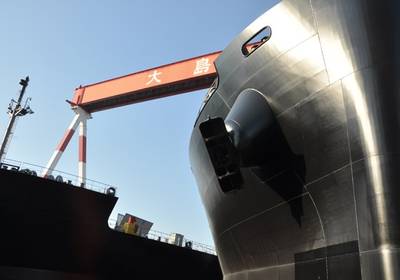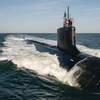Ship construction rules for oil tankers and bulk carriers submitted by 12 classification societies conform to the goals and functional requirements set by the International Maritime Organization (IMO), marking a new development in how international standards for ship construction are determined and implemented. For the first time, IMO has been given a role in auditing and verifying the structural rules developed by the classification societies for newbuild oil tankers and bulk carriers.
According to the IMO, the philosophy behind goal-based standards for bulk carriers and oil tankers is that ships should be designed and constructed for a specified design life and that, if properly operated and maintained, they should remain safe and environmentally friendly throughout their service life.
Regulation II-1/3-10 of the International Convention for the Safety of Life at Sea (SOLAS) applies this philosophy to new oil tankers and bulk carriers over 150 meters in length. Under the regulation, such ships must have adequate strength, integrity and stability to minimize the risk of loss of the ship or pollution to the marine environment due to structural failure, including collapse, resulting in flooding or loss of watertight integrity.
The IMO’s Maritime Safety Committee (MSC)reviewed goal-based standards verification audit reports on 12 Recognized Organizations (ROs) which are members of the International Association of Classification Societies (IACS). The audits were carried out by teams of experts nominated by IMO Member States.
The Committee confirmed that the 12 ROs’ ship construction rules were in conformity with the goals and functional requirements set out in the International goal-based ship construction standards for bulk carriers and oil tankers. The MSC also confirmed that ships contracted under the current verified rules are deemed to meet the GBS Standards.
The goal-based standards amendments in SOLAS regulation II-1/3-10 were adopted in 2010 and entered into force in 2012, with a date of July 1, 2016 set for application to new oil tankers and bulk carriers.
IMO Secretary-General Kitack Lim said the verification process which had now been completed was a significant step for IMO, since until now, there had been no direct oversight by IMO of the classification societies’ structural rules.
While there has not been any doubt that classification societies have for many years ensured the full implementation of all applicable IMO standards, including those in SOLAS and MARPOL, the detail of ship construction has been the remit of classification societies. The goal-based standards verification audit process means that all aspects of ship construction for oil tankers and bulk carriers now have to be verified and audited as meeting the established goals.
“The completion of this process of developing goal-based standards for oil tankers and bulk carriers, followed by the detailed verification audit process, means that we now have a much closer alignment between the classification societies’ rules and the IMO regulatory process. This marks a very significant development in the IMO rule making process,” Lim said.
The goal-based standards for oil tankers and bulk carriers adopted by IMO set goals and functional requirements associated with those goals. An important element of the verification process has been to confirm that the classification societies’ rules and regulations do indeed ensure that the functional requirements included in the goals, and therefore the goals themselves, will be met.
The goals are defined as follows:
Ships shall be designed and constructed to be safe and environmentally friendly for a specified design life, when properly operated and maintained under the specified operating and environmental conditions, in intact and specified damage conditions, throughout their life.
Safe and environmentally friendly means the ship shall have adequate strength, integrity and stability to minimize the risk of loss of the ship or pollution to the marine environment due to structural failure, including collapse, resulting in flooding or loss of watertight integrity.
Environmentally friendly also requires the ship to be constructed of materials acceptable for environment-friendly recycling.
Safety applies to the ship's structure, fittings and arrangements providing for safe access, escape, inspection and proper maintenance and facilitating safe operation.
Specified operating and environmental conditions are defined by the intended operating area for the ship throughout its life and cover the conditions, including intermediate conditions, arising from cargo and ballast operations in port, waterways and at sea.
Specified design life is the nominal period that the ship is assumed to be exposed to operating and/or environmental conditions and/or the corrosive environment and is used for selecting appropriate ship design parameters. However, the ship's actual service life may be longer or shorter depending on the actual operating conditions and maintenance of the ship throughout its life.
The functional requirement II.1 on Design life states that the “specified design life shall not be less than 25 years”.
Another example of a functional requirement is: II.14 Structural accessibility: “The ship shall be designed, constructed and equipped to provide adequate means of access to all internal structures to facilitate overall and close-up inspections and thickness measurements.”
In order to meet the goals and functional requirements, classification societies acting as recognized organizations and/or national Administrations develop specific rules and regulations (for example, to achieve the ‘adequate means of access’). These detailed requirements become part of a goal-based standards framework when they have been verified, by independent auditors and IMO, as conforming to the goal-based standards. A detailed ship construction file must be provided for each ship.
SOLAS regulation II-1/3-10 on Goal-based ship construction standards for bulk carriers and oil tankers (resolution MSC.290(87)), which entered into force on 1 January 2012, requires that all oil tankers and bulk carriers of 150 m in length and above, for which the building contract is placed on or after 1 July 2016, satisfy applicable structural requirements conforming to the functional requirements of the International Goal-based Ship Construction Standards for Bulk Carriers and Oil Tankers (GBS Standards) (resolution MSC.287(87)).












